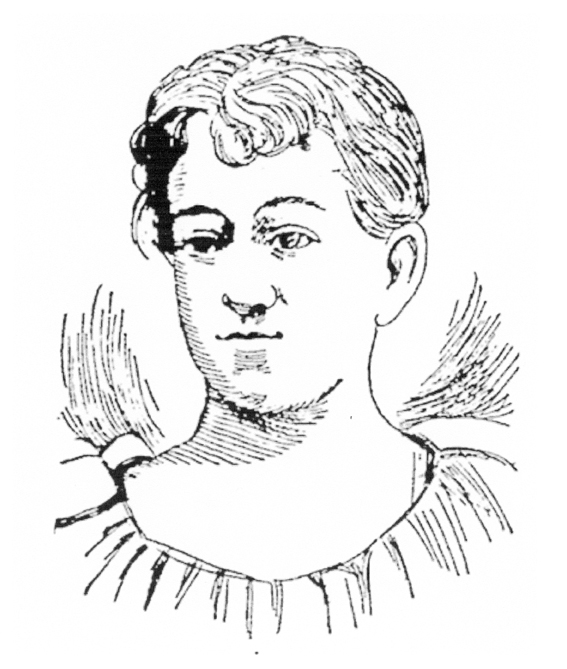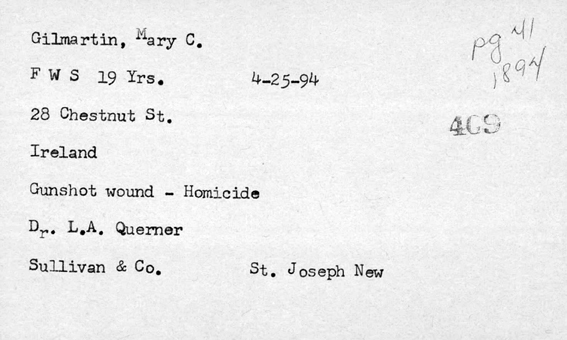By Kevin Grace
 This week’s posting to acknowledge the “Peoples of Ohio” theme of Archives Month, and the Irish in southwest Ohio is the tragic tale of young Mollie Gilmartin. Born in County Sligo, Mary “Mollie” Gilmartin was the object of affection from her family’s parish priest, Dominick O’Grady. Seeking to end the unwanted attention, her family decided a new life in America would be best for Molllie, so in September 1893, they sent her to Chicago where her brother Michael was a priest. The intent was for Michael to look after her while she built a new life for herself, but O’Grady followed her across the ocean.
This week’s posting to acknowledge the “Peoples of Ohio” theme of Archives Month, and the Irish in southwest Ohio is the tragic tale of young Mollie Gilmartin. Born in County Sligo, Mary “Mollie” Gilmartin was the object of affection from her family’s parish priest, Dominick O’Grady. Seeking to end the unwanted attention, her family decided a new life in America would be best for Molllie, so in September 1893, they sent her to Chicago where her brother Michael was a priest. The intent was for Michael to look after her while she built a new life for herself, but O’Grady followed her across the ocean.
As it turned out, there was, in fact, some exchange of sentiment between the two as O’Grady and Mollie wrote romantic letters to each other. Afraid that O’Grady would disrupt his sister’s life in Chicago, Michael Gilmartin sent Mollie to Cincinnati in January of 1894 to take up temporary residence with some cousins who lived on Chestnut Street. Once more, O’Grady followed her. On a late April morning as Mollie left the house to go to her job with the Pulvermachers Galvanic Belt Company, the spurned priest caught up to her. He pulled a revolver from his pocket and fired several shots. Mollie died on the street. O’Grady was quickly arrested by the police, and gave the officers a false name, “George Reed.” His ruse was short-lived and he soon confessed. Locked up in jail, he managed to get his hands on some poison and tried to commit suicide by drinking poison, but he failed.
At his trial, O’Grady was found insane and committed to the Longview Asylum. However, four years later, it was determined that he had regained his faculties and was reinstated as a priest. But Mollie’s sad tale was not ended. The Sullivan Funeral Home prepared her remains, and dozens of the Cincinnati Irish community attended the funeral, carrying her body to the New St. Joseph Cemetery in Price Hill, the resting place for many of the city’s Irish Americans. For decades, though, she lay in an unmarked grave. In 2011, relatives of Mollie’s back in Ireland who knew something of her fate yearned to learn more so they could resolve the family’s questions on what had happened to their young ancestor. With the help of the Cincinnati Police Department and historians at the Cincinnati Heritage Center, the facts of the case were finally revealed. Shortly thereafter, a Gilmartin relative came from Ireland to place a headstone over the grave, and a memorial service was held in Sligo. Mollie Gilmartin, and her descendants, have closure.
Regarding the images presented here, the sketch of Mollie Gilmartin is one that was carried in several newspapers that carried accounts of the murder and trial, and the death card is from the holdings of Cincinnati birth and death records in the Archives & Rare Books Library. These records, more than 500,000 of them, were digitized with a Library Services and Technology Grant, awarded by the State Library of Ohio. To learn more about the research materials in the Archives & Rare Books Library, please telephone 513.556.1959, email at archives@ucmail.uc.edu, or visit the website at http://www.libraries.uc.edu/libraries/arb/index.html.

